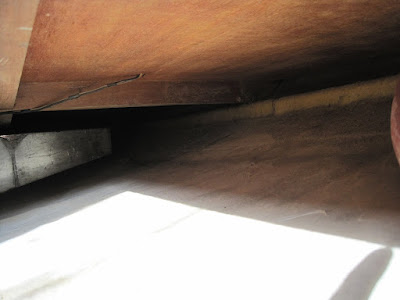▼
Thursday, August 18, 2011
Tuesday, July 12, 2011
What Supports the Teak and Holly Sole?
So what does support the 13/16" thick floor boards? In a nutshell, floor joists. The joists are 2" thick by 1-3/4" wide. There's a stringer, fiberglassed into the hull, upon which the joists, running athwart, rest upon. The joists are fixed to the stringer by fiberglass. According to Tommy Chen, inside the stringer is a wood called 'Yako' which is very much like iron wood.

Looking forward and outboard on the starboard side. The stainless water tank is forward.

Looking outboard at the floor support structure. Starting at the bottom are: (1) turn of the bilge for the fiberglass hull; (2) a stringer fiberglassed to the hull; (3) a floor joist that has been fiberglassed to both the stringer and the hull; and (4) a fixed portion of the floor.
Saturday, May 7, 2011
Wet Muffler Failures and the Injection Elbow
Some LNVTs with over 4000 hours on their Cummins engines have reported wet muffler failures. Autopsies of these mufflers turned up melted components. After the obvious causes were eliminated, broken impeller, blocked thru-hull, etc, it was thought that the melting was due to poor muffler material selection by the manufacturer. However, the cause may very well lie in the exhaust's wet injection elbow. Over time carbon build-up in the elbow reduces the raw water's cooling efficiency. Cooling efficiency is important because depending on RPM the exhaust's temperature is between 350 and 800F. The muffler, which is only about 3' away from the elbow and made of FRP, can withstand temperatures to around 250F. Thus an engine running at high RPM that has carbon build-up in the injection elbow could conceivably go over-temp in the muffler. A recent inspection of Nellie D.'s (63) 4500 hour elbow showed significant carbon build-up. When the carbon was removed from the elbow, extensive crevice corrosion was found. So much so that the elbow had to be replaced. It's probable that the crevice corrosion was exacerbated by the carbon because it allowed a very caustic micro environment to form.
I now have many good reasons to bi-annually inspect for and remove carbon build-up on the inside of the elbow, not the least of which is its $1600 replacement cost.
For some good background information I recommend the following articles:
Saturday, January 8, 2011
Gel Coat Rub Rail Cracking Revisited (see also 20 December 2010)
Gel coat should be applied anywhere from .012" to .026" thick. A sample of gel coat just below Nellie's waterline measured .019", well within tolerances. However, as the picture at right shows, the crack's gel coat thickness is three to four times the ideal.

